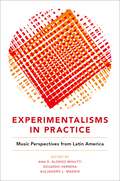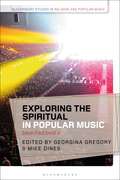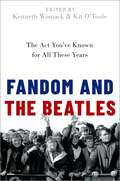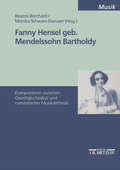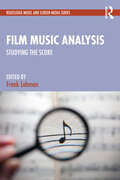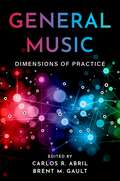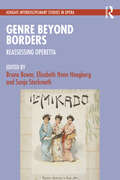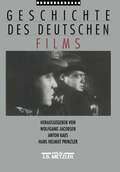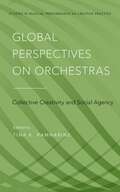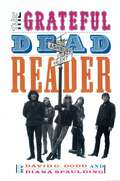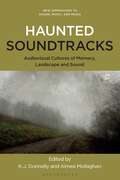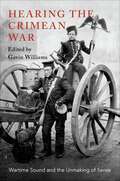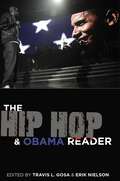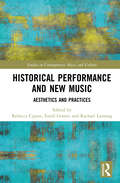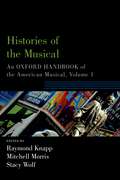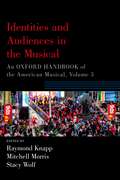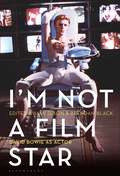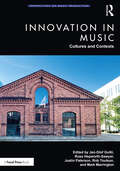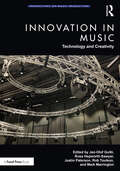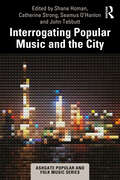- Table View
- List View
Experimentalisms in Practice: Music Perspectives from Latin America
Experimentalisms in Practice explores the multiple sites in which experimentalism emerges and becomes meaningful beyond Eurocentric interpretative frameworks. Challenging the notion of experimentalism as defined in conventional narratives, contributors take a broad approach to a wide variety of Latin@ and Latin American music traditions conceived or perceived as experimental. The conversation takes as starting point the 1960s, a decade that marks a crucial political and epistemological moment for Latin America; militant and committed aesthetic practices resonated with this moment, resulting in a multiplicity of artistic and musical experimental expressions. Experimentalisms in Practice responds to recent efforts to reframe and reconceptualize the study of experimental music in terms of epistemological perspective and geographic scope, while also engaging traditional scholarship. This book contributes to the current conversations about music experimentalism while providing new points of entry to further reevaluate the field.
Exploring the Spiritual in Popular Music: Beatified Beats (Bloomsbury Studies in Religion and Popular Music)
This book highlights how the diverse nature of spiritual practices are experienced and manifest through the medium of popular music. At first glance, chapters on Krishnacore, the Rave Church phenomenon and post-punk repertoire of Psychic TV may appear to have little in common; however, this book draws attention to some of the similarities of the nuances of spiritual expression that underpin the lived experience of popular music. As an interdisciplinary volume, the extensive introduction unpacks and clarifies terminology relating to the study of religion and popular music.The cross-disciplinary approach of the book makes it accessible and appealing to scholars of religious studies, cultural studies, popular music studies and theology. Unlike existing collections dealing with popular music and religion that focus on a specific genre, this innovative book offers a range of music and case studies, with chapters written by international contributors.
Fandom and The Beatles: The Act You've Known for All These Years
More than 50 years after their breakup, the Beatles are still attracting fans from various generations, all while retaining their original fan base from the 1960s. Why have those first-generation fans continued following the Beatles and are now introducing their grandchildren to the group? Why are current teens affected by the band's music? And perhaps most importantly, how and why do the Beatles continue to resonate with successive generations? Unlike other bands of their era, the Beatles seem permanently frozen in time, having never descended into "nostalgia act" territory. Instead, even after the announcement of the band's breakup in 1970, the group has maintained its cultural and musical relevance. Their timeless quality appeals to younger generations while maintaining the loyalty of older fans. While the Beatles indeed represent a specific time period, their music and words address issues as meaningful today as they were during the Summer of Love: politics, war, sex, drugs, art, and creative liberation. As the first anthology to assess the nature of fan response and the band's enduring appeal, Fandom and the Beatles: The Act You've Known for All These Years defines and explores these unique qualities and the key ways in which this particular pop fusion has inspired such loyalty and multigenerational popularity.
Fanny Hensel geb. Mendelssohn Bartholdy: Komponieren zwischen Geselligkeitsideal und romantischer Musikästhetik. Internationales Symposion an der Hochschule der Künste Berlin vom 28. - 30. November 1997. M&P Schriftenreihe
Film Music Analysis: Studying the Score (Routledge Music and Screen Media Series)
Since the establishment of film music studies, there has been a steady growth of serious analytical work on the film music repertoire. Film Music Analysis: Studying the Score offers the first collection of essays dedicated to the close investigation of musical structure and meaning in film music. Showcasing scholarship from a diverse and distinguished group of music theorists and musicologists, this book presents the many ways to inspect the inner workings of film music in a manner that is exciting and accessible to anyone curious about this music, regardless of their background in film or music theory.Each chapter takes as its focus one music-theoretical parameter and explores how that concept can be used to analyze and interpret film music. Covering theoretical concepts that range from familiar categories such as leitmotif and pitch structure to more cutting-edge ideas such as timbral associativity, topic theory, and metrical states, the book provides a toolkit with which to explore this captivatingly varied repertoire. With example analyses drawn from classic and contemporary films, Film Music Analysis: Studying the Score is a valuable teaching tool and an indispensable addition to the library of any lover of film and music.
The Future of Live Music
What 'live music' means for one generation or culture does not necessarily mean 'live' for another. This book examines how changes in economy, culture and technology pertaining to post-digital times affect production, performance and reception of live music. Considering established examples of live music, such as music festivals, alongside practices influenced by developments in technology, including live streaming and holograms, the book examines whether new forms stand the test of 'live authenticity' for their audiences. It also speculates how live music might develop in the future, its relationship to recorded music and mediated performance and how business is conducted in the popular music industry.
General Music: Dimensions of Practice
General Music: Dimensions of Practice is a practical guide for music teachers and teaching artists who strive to teach music holistically. The book begins by framing general music as a holistic music education that is comprehensive, meaningful, and relevant to diverse learners in school and community settings. It is followed by chapters that are organized into one of four dimensions of music practice: performing, connecting, creating, and responding. Chapter authors share creative and innovative teaching ideas, for both elementary and secondary school students, that focus on a wide range of topics, including: songwriting, composing, improvising, singing, moving, playing, listening, analyzing, contextualizing, and connecting. Each chapter provides (a) a rationale for a given area of music study, establishing its importance and relevance; (b) a research or theoretical background, to inform and guide practice; and (c) a pedagogical model or framework illustrated through lesson ideas, curriculum units, or vignettes. The ideas in this book seek to inspire and guide teachers as they build comprehensive music programs that are informed by students and communities.
Genre Beyond Borders: Reassessing Operetta (Ashgate Interdisciplinary Studies in Opera)
This book offers an innovative approach to understanding operetta, drawing attention to its malleability and resistance to boundaries. These shows have traversed (and continue to traverse) with ease the national borders which might superficially define them, or draw on features from many other genres without fundamentally changing in tone or approach. The chapters move from nineteenth-century London and Paris to twentieth-century North America, South America and Europe to present-day Australia. Some offer fresh understandings of familiar composers, such as Johann Strauss or Gilbert and Sullivan, while others examine works or composers that are less well-known. The chapter on Socialist operetta in Czechoslovakia in particular will almost certainly be a revelation to anyone from Western Europe or the US, where operetta is often understood to be a bourgeois phenomenon. As a summary of the current state of the field, this collection showcases the many possible pathways for future scholars who wish to explore it.
Geschichte der musikalischen Interpretation im 19. und 20. Jahrhundert, Band 3: Aspekte - Parameter
Nachdem Band 1 Ästhetik und Ideengeschichte, Band 2 Institutionen und Medien der Interpretation thematisiert haben, befasst sich Band 3 mit der klingenden Interpretation selbst. Behandelt werden all jene Kategorien, die für Interpretation und ihre Wahrnehmung grundlegend sind: · Tempo und Tempomodifikationen, Dynamik, Phrasierung und Artikulation, Portamento und Vibrato, Textaussprache, Stimmung und Intonation.· die verwendeten Instrumente mit ihren spieltechnischen Möglichkeiten und Grenzen einschließlich der menschlichen Stimme· „Medien“ der Interpretation: Körper, Raum sowie die technischen Medien der Speicherung und Reproduktion, die Tonträger. Von fundamentaler Bedeutung ist ferner die Frage, in welchem Umfang man dem Notentext einer Komposition folgt bzw. von ihm abweicht („Willkürliche Veränderungen“, „Retuschen“, Ensemblekoordination), und welche Rolle regionale Differenzen bei der Interpretation spielen.
Global Perspectives on Orchestras: Collective Creativity and Social Agency (Studies in Musical Perf as Creative Prac)
Offering innovative approaches to thinking about orchestras, Global Perspectives on Orchestras: Collective Creativity and Social Agency adopts ethnographic, historical and comparative perspectives on a variety of traditions, including symphony, Caribbean steel, Indonesian gamelan, Indian film and Vietnamese court examples. The volume presents compelling analyses of orchestras in their socio-historical, economic, intercultural and postcolonial contexts, while emphasizing the global and historical connections between musical traditions. By drawing on new ethnographic and historical data, the essays describe orchestral creative processes and the politics shaping performance practices. Each essay considers how musicians work together in ensembles, focusing on issues such as training, rehearsal, creative choices, compositional processes, and organizational infrastructures. Testimonies of orchestral musicians highlight practitioners' views into the diverse world of orchestras. As a whole, the volume discusses the creative roles of performers, arrangers, composers and arts agencies, as well as the social environments supporting musical collaborations. With contributions from an international team of researchers, Global Perspectives on Orchestras offers critical insights gained from the study of orchestras, collective creativity and social agency, and the connections between orchestral performances, colonial histories, postcolonial practices, ethnographic writings and comparative theorizations.
The Grateful Dead Reader (Readers on American Musicians)
Arranged in chronological order, these pieces add up to nothing less than a full-scale history of the greatest tour band in the history of rock. From Tom Wolfe's account of the Dead's first performance as the Grateful Dead (at an Acid Test in 1965), to Ralph Gleason's 1967 interview with the 24-year-old Jerry Garcia, to Mary Eisenhart's obituary of the beloved leader of the band, these selections include not only outstanding writing on the band itself, but also superb pieces on music and pop culture generally. Fans will be fascinated by the poetry, fiction, drawings, and rare and revealing photographs featured in the book, as well as the anthology's many interviews and profiles, interpretations of lyrics, and concert and record reviews. Still, The Grateful Dead was more than a band--it was a cultural phenomenon. For three decades it remained on one unending tour, followed everywhere by a small army of nomadic fans. This phenomenon is both analyzed and celebrated here, in such pieces as Ed McClanahan's groundbreaking article in Playboy in 1972, fan-magazine editor Blair Jackson's 1990 essay on the seriousness of the drug situation at Dead concerts, and Steve Silberman's insightful essays on the music and its fans.
Haunted Soundtracks: Audiovisual Cultures of Memory, Landscape, and Sound (New Approaches to Sound, Music, and Media)
The turn of the millennium has heralded an outgrowth of culture that demonstrates an awareness of the ephemeral nature of history and the complexity underpinning the relationship between location and the past. This has been especially apparent in the shifting relationship between landscape, memory and sound in film, television and other media. The result is growing interest in soundtracks, as part of audiovisual culture, as well as an interest in the spectral aspects of culture more generally. This collection of essays focuses on audiovisual forms that foreground landscape, sound and memory. The scope of inquiry emphasises the ghostly qualities of a certain body of soundtracks, extending beyond merely the idea of 'scary films' or 'haunted houses.' Rather, the notion of sonic haunting is tied to ideas of trauma, anxiety or nostalgia associated with spatial and temporal dislocation in contemporary society. Touchstones for the approach are the concepts of psychogeography and hauntology, pervasive and established critical strategies that are interrogated and refined in relation to the reification of the spectral within the soundtracks under consideration here.
Hearing the Crimean War: Wartime Sound and the Unmaking of Sense
What does sound, whether preserved or lost, tell us about nineteenth-century wartime? Hearing the Crimean War: Wartime Sound and the Unmaking of Sense pursues this question through the many territories affected by the Crimean War, including Britain, France, Turkey, Russia, Italy, Poland, Latvia, Dagestan, Chechnya, and Crimea. Examining the experience of listeners and the politics of archiving sound, it reveals the close interplay between nineteenth-century geographies of empire and the media through which wartime sounds became audible--or failed to do so. The volume explores the dynamics of sound both in violent encounters on the battlefield and in the experience of listeners far-removed from theaters of war, each essay interrogating the Crimean War's sonic archive in order to address a broad set of issues in musicology, ethnomusicology, literary studies, the history of the senses and sound studies.
Hip Hop around the World [2 volumes]: An Encyclopedia [2 volumes]
This set covers all aspects of international hip hop as expressed through music, art, fashion, dance, and political activity.Hip hop music has gone from being a marginalized genre in the late 1980s to the predominant style of music in America, the UK, Nigeria, South Africa, and other countries around the world. Hip Hop around the World includes more than 450 entries on global hip hop culture as it includes music, art, fashion, dance, social and cultural movements, organizations, and styles of hip hop. Virtually every country is represented in the text. Most of the entries focus on music styles and notable musicians and are unique in that they discuss the sound of various hip hop styles and musical artists' lyrical content, vocal delivery, vocal ranges, and more. Many additional entries deal with dance styles, such as breakdancing or b-boying/b-girling, popping/locking, clowning, and krumping, and cultural movements, such as black nationalism, Nation of Islam, Five Percent Nation, and Universal Zulu Nation. Country entries take into account politics, history, language, authenticity, and personal and community identification. Special care is taken to draw relationships between people and entities such as mentor-apprentice, producer-musician, and more.
The Hip Hop & Obama Reader
Featuring a foreword by Tricia Rose and an Afterword by Cathy J. Cohen Barack Obama flipped the script on more than three decades of conventional wisdom when he openly embraced hip hop--often regarded as politically radioactive--in his presidential campaigns. Just as important was the extent to which hip hop artists and activists embraced him in return. This new relationship fundamentally altered the dynamics between popular culture, race, youth, and national politics. But what does this relationship look like now, and what will it look like in the decades to come? The Hip Hop & Obama Reader attempts to answer these questions by offering the first systematic analysis of hip hop and politics in the Obama era and beyond. Over the course of 14 chapters, leading scholars and activists offer new perspectives on hip hop's role in political mobilization, grassroots organizing, campaign branding, and voter turnout, as well as the ever-changing linguistic, cultural, racial, and gendered dimensions of hip hop in the U.S. and abroad. Inviting readers to reassess how Obama's presidency continues to be shaped by the voice of hip hop and, conversely, how hip hop music and politics have been shaped by Obama, The Hip Hop & Obama Reader critically examines hip hop's potential to effect social change in the 21st century. This volume is essential reading for scholars and fans of hip hop, as well as those interested in the shifting relationship between democracy and popular culture.
Historical Performance and New Music: Aesthetics and Practices
The worlds of new music and historically informed performance might seem quite distant from one another. Yet, upon closer consideration, clear points of convergence emerge. Not only do many contemporary performers move easily between these two worlds, but they often do so using a shared ethos of flexibility, improvisation, curiosity, and collaboration—collaboration with composers past and present, with other performers, and with audiences. Bringing together expert scholars and performers considering a wide range of issues and case studies, Historical Performance and New Music—the first book of its kind—addresses the synergies in aesthetics and practices in historical performance and new music. The essays treat matters including technologies and media such as laptops, printing presses, and graphic notation; new music written for period instruments from natural horns to the clavichord; personalities such as the pioneering singer Cathy Berberian; the musically “omnivorous” ensembles A Far Cry and Roomful of Teeth; and composers Luciano Berio, David Lang, Molly Herron, Caroline Shaw, and many others. Historical Performance and New Music presents pathbreaking ideas in an accessible style that speaks to performers, composers, scholars, and music lovers alike. Richly documented and diverse in its methods and subject matter, this book will open new conversations about contemporary musical life.
Histories of the Musical: An Oxford Handbook of the American Musical, Volume 1 (Oxford Handbooks)
The American musical is a paradox. On stage or screen, musicals at once hold a dominant and a contested place in the worlds of entertainment, art, and scholarship. Born from a mélange of performance forms that included opera and operetta, vaudeville and burlesque, minstrelsy and jazz, musicals have always sought to amuse more than instruct, and to make money more than make political change. In spite of their unapologetic commercialism, though, musicals have achieved supreme artistry and have influenced culture as much as if not more than any other art form in America, including avant-garde and high art on the one hand, and the full range of popular and commercial art on the other. Reflecting, refracting, and shaping U.S. culture since the early twentieth century, musicals converse with shifting dynamics of gender and sexuality, ethnicity and race, and the very question of what it means to be American and to be human. The chapters gathered in this book, Volume I of the reissued Oxford Handbook, explore the American musical from both the outside and the inside. This first volume concentrates in particular on large-scale, more philosophical issues of relevance to the genre, considering issues of historical situations and formal procedure as they bear on the narratives we make concerning productions and performers, artists and audiences, commerce and context. The first four essays discuss ways of defining histories and texts, and apprehending the formal choices of singers and dancers; the second group of four take up the subtle challenges of the genre's signal transformations out of minstrelsy and Tin Pan Alley to "integration" and beyond.
Historische Musikwissenschaft: Grundlagen und Perspektiven
Grundsätzliches und Interdisziplinäres. Welches sind die Fragen und Methoden der Historischen Musikwissenschaft? Und im Rahmen aktueller Debatten in Kunst-, Literatur- und Kulturwissenschaft: Kann sie damit Anschluss an diese Disziplinen finden? Die Autoren des Bandes erörtern musikalische und musikwissenschaftliche Phänomene aus Geschichte und Gegenwart und erproben Zugänge aus historischer, soziologischer, ästhetischer, medientheoretischer, philologischer oder kulturwissenschaftlicher Sicht.
Identities and Audiences in the Musical: An Oxford Handbook of the American Musical, Volume 3 (Oxford Handbooks)
Issues of identity have always been central to the American musical in all its guises. Who appears in musicals, who or what they are meant to represent, and how, over time, those representations have been understood and interpreted, provide the very basis for our engagement with the genre. In this third volume of the reissued Oxford Handbook of the American Musical, chapters focus on race, ethnicity, gender, and sexuality, regional vs. national identity, and the cultural and class significance of the musical itself. As important as the question of who appears in musicals are the questions of who watches and listens to them, and of how specific cultures of reception attend differently to the musical. Chapters thus address cultural codes inherent to the genre, in particular those found in traditional school theater programs.
I’m Not a Film Star: David Bowie as Actor
The first collection dedicated to David Bowie's acting career shows that his film characterisations and performance styles shift and reform as decoratively as his musical personas. Though he was described as the most influential pop artis of the 20th century, whose work became synonymous with mask, mystery, sexual excess and ch-ch-ch-changing genres, Bowie also applied his genius to the craft of acting.Bowie's considerable filmography is systematically examined in 12 scholarly essays that include tributes to Bowie's performance craft in other media forms. Classic films such as The Prestige and Merry Christmas, Mr. Lawrence, cult hits Labyrinth and The Man Who Fell To Earth, as well as lesser-known roles in The Image, Christiane F. and Broadway hit The Elephant Man are viewed, not simply through the lens of Bowie's mega-stardom, but as the work of a serious actor with inimitable talent. This compelling analysis celebrates the risk-taking intelligence and bravura of David Bowie: actor, mime, mimic and icon.
Individualität in der Musik
Musiktheoretische und musikwissenschaftliche, produktionsästhetische und aufführungspraktische, philosophische und semiotische Aspekte des Individualitätsbegriffes werden in neun, jeweils zwei bis vier Beiträge enthaltenden Sektionen beleuchtet. Zur Sprache kommen dabei u. a. die Faszinationskraft des Individuellen, Individuation als Prozess der Werkgenese und als dem Werk eingeschriebene musikalische Bewegung, das Verhältnis von Individualität und Norm, die Beziehung zwischen musikalischer Zeit und lebenszeitlicher Erfahrung, Negation und Reduktion des Individuellen in Werken des 20. Jahrhunderts sowie ökonomische Aspekte des Individualitätsbegriffs. Mit diesem aus einem Symposion der Berliner Hochschule der Künste und der TU Berlin hervorgegangenen Band setzen die Herausgeber von »Klang Struktur Metapher. Musikalische Analyse zwischen Phänomen und Begriff« ihr Konzept fort, junge KomponistInnen und WissenschaftlerInnen aus verschiedenen Disziplinen in der Diskussion eines Themas von fachübergreifender Relevanz zusammenzuführen.
Innovation in Music: Cultures and Contexts (ISSN)
Innovation in Music: Cultures and Contexts is a groundbreaking collection bringing together contributions from instructors, researchers, and professionals. Split into two sections, covering creative production practices and national/international perspectives, this volume offers truly global outlooks on ever-evolving practices.Including chapters on Dolby Atmos, the history of distortion, creativity in the pandemic, and remote music collaboration, this is recommended reading for professionals, students, and researchers looking for global insights into the fields of music production, music business, and music technology.
Innovation in Music: Technology and Creativity (ISSN)
Innovation in Music: Technology and Creativity is a groundbreaking collection bringing together contributions from instructors, researchers, and professionals. Split into two sections, covering composition and performance, and technology and innovation, this volume offers truly international perspectives on ever-evolving practices.Including chapters on audience interaction, dynamic music methods, AI, and live electronic performances, this is recommended reading for professionals, students, and researchers looking for global insights into the fields of music production, music business, and music technology.
Interrogating Popular Music and the City (ISSN)
How does popular music influence the culture and reputation of a city, and what does a city do to popular music? Interrogating Popular Music and the City examines the ways in which urban environments and music cultures intersect in various locales around the globe. Music and cities have been partners in an often clumsy, sometimes accidental but always exciting dance. Heritage and immigration, noise and art, policy and politics are some of the topics that are addressed in this critical examination of relationships between cities and music. The book draws upon an international array of researchers, encompassing hip hop in Beijing; the city favelas of Brazil; from Melbourne bars to European parliaments; to heritage and tourism debates in Salzburg and Manchester. In doing so, it interrogates the different agendas of audiences, musicians and policy-makers in distinct urban settings.
